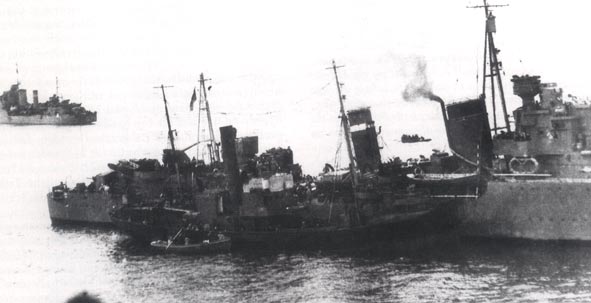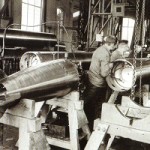After a brief lull in the Battle of the Atlantic during January, 1941, German U-boats began to sink increasing numbers of Allied ships: 47 ships in February and 50 ships in March. But in March, a naval engagement off the coast of Norway was about to produce a valuable prize for Britain’s Bletchley Park code breakers. (See my blog, “Decoding Enigma: Success and Setback,” June 18, 2018.)
During a March 4th British commando raid, a Royal Navy destroyer engaged in a brief gun battle that left a German trawler disabled and burning. While the Germans abandoned their crippled ship, a three-man boarding party went across to the trawler. The leader of the party, Lt. Sir Marshall Warmington, broke into a locked desk in the captain’s quarters and found a wooden box containing two small, ratcheted wheels. Although he hadn’t been briefed on the German Navy’s Enigma coding device, Warmington thought the box looked intriguing. He retrieved it and some unimportant looking papers.
The papers turned out to be a bonanza for the Bletchley cryptanalysts. They contained Enigma settings for February, helping the analysts read several encoded German Navy messages from the previous month. With the help of these “cribs,” the analysts were able to construct the German bi-gram (two-letter) table used in transmitting the Enigma settings for individual messages. Even with this advantage, however, the decoding process still took weeks to complete.
To speed up the process, the Royal Navy quietly began putting together plans to capture a U-boat or other German naval vessel in hopes of obtaining more current Enigma codebooks. Thus far in the war, however, the Royal Navy had realized only limited success in sinking U-boats, let alone capturing one.
At this point, a radio traffic analyst at Bletchley Park proposed an inspired solution. In looking through the decrypted messages, Harry Hinsley saw that the Germans were sending trawlers to the seas north of Iceland to observe and report the weather conditions back to naval headquarters. Hinsley believed these lonely ships were equipped with Enigma machines and codebooks in order to send and receive certain secret messages. If such a ship suddenly came under attack, he reasoned, the crew might think to throw overboard their Enigma device and current codebooks, but likely would be too panicked to take the time to retrieve and destroy the next month’s codes, locked away for safekeeping.
The plan worked exactly as envisioned. On the afternoon of May 7, 1941, a Royal Navy destroyer opened fire as it raced toward the German trawler München. Moments after the trawler’s crew were picked up by the British, a boarding party from the destroyer climbed aboard the München, and this time they were joined by a London-based Intelligence officer who had been told what to look for and where he was likely to find it.
As expected, München’s crew had disposed of the Enigma machine and current codebooks, but not the codebooks for June. Three days later, the June codes were delivered to cryptanalysts at Bletchley, a gift that would allow them to read the German Navy’s June radio traffic within hours of it being sent.
Yet even as this operation was being hailed, another trove of information was falling into Royal Navy hands, courtesy of the same U-boat commander whose attack on the passenger ship Athenia had begun the Battle of the Atlantic 20 months earlier. More about that dramatic action in our next blog.





